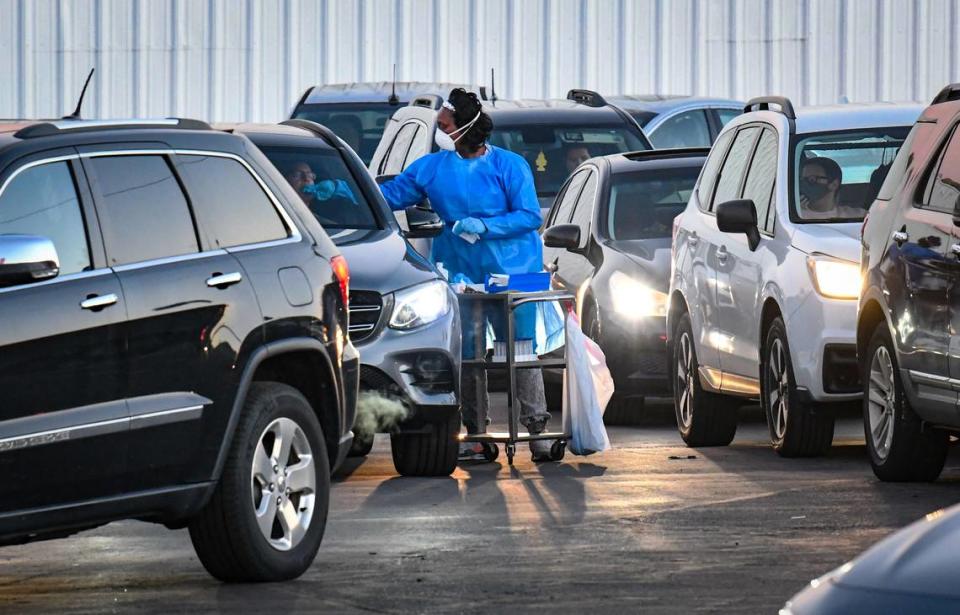COVID-19 in Charlotte: Record-breaking day for new cases as positivity rate rises
In the past two weeks, Mecklenburg County has shattered local coronavirus records — far exceeding the testing volumes and hospitalizations seen during the region’s first coronavirus peak in late July.
On Friday, the county logged its steepest-single day increase yet, with 651 new cases, the North Carolina Department of Health and Human Services reported. That replaced a record of 548 set the day prior and 534 new infections, another recent high, from less than two weeks ago. Since the beginning of the pandemic, Mecklenburg has seen 44,976 cases, according to the latest state figures.
Because day-to-day figures fluctuate, health experts look at trends and averages over one or two week periods. In Mecklenburg, according to DHHS figures analyzed by The Charlotte Observer, the 14-day average of new lab-confirmed cases per day is 411. That’s higher than during the July peak when the average was 332.
And health officials and epidemiologists warn the recent sobering statistics are just a prelude to what’s awaiting Charlotte in this second COVID-19 wave, largely fueled by Thanksgiving — and soon, Christmas and New Year’s — gatherings.
Michael Thompson, associate chair of the Public Health Sciences department at UNC Charlotte, said Mecklenburg is at a critical inflection point.
”We’ve been kind of drifting upward through the early part of the fall and now (it’s) pretty widespread,” Thompson said of the caseload. “Everyone’s fearing what has happened with this Thanksgiving break. Is it going to explode up to that next level?”

Already, Mecklenburg’s death toll — which reached 468 on Thursday afternoon — is rising again at a concerning pace.
In October, 33 residents died of coronavirus-related complications, an Observer review of county public health finds. The number nearly doubled in November, with Mecklenburg officials reporting 63 fatalities.
Deaths are considered a lagging indicator in the coronavirus pandemic, reflecting the scope and severity of infections circulating in a community several weeks (and sometimes, months) ago, said Dr. David Rubin, director of PolicyLab at Children’s Hospital of Philadelphia.
The timeline is based on the incubation period of the virus, plus how long it takes people to start experiencing symptoms, get tested for COVID-19 and seek hospital-level care. In Mecklenburg, for example, deaths rose by nearly 56% in August — reflecting the impact of the July peak in hospitalizations.
“There is some degree we’ve improved the treatment of COVID over time,” Rubin said. “But if we begin to overfill our hospitals — you can have a room, but if you don’t have a nurse and staff to care for them — you start to run into a situation that we call ‘failure to rescue.’ ”
Mecklenburg officials have not publicly disclosed when the next peak might occur — and just how sharply the numbers could climb without imposing certain restrictions, like another stay-at-home order.
Rubin said the high transmission rate could have devastating impacts for vulnerable communities, especially if more long-term care facilities — including nursing homes — grapple with COVID-19 outbreaks. Just over half of Mecklenburg’s deaths are linked to those facilities, with nearly 30 in active outbreak status, the latest data shows.
Dr. Mandy Cohen, the N.C DHHS secretary, urged North Carolinians on Thursday to keep following coronavirus safeguards, including wearing face masks and practicing social distancing, amid sweeping spread of the virus.
“We can all do things right now to slow the spread of the virus — we have to,” Cohen said in a news conference. “Our hospitalizations are going up and people are dying.”
Local COVID-19 trends
Health experts say hospitalization and death trendlines offer the clearest snapshot of the pandemic, particularly in gauging the availability of medical resources.
Other closely watched metrics — including the new daily caseload and COVID-19 positivity rate — could become muddled or under-represent infections if there’s a testing backlog. Some testing sites reported delayed turnaround times before Thanksgiving, though they have since stabilized, Mecklenburg Public Health Director Gibbie Harris told county commissioners on Tuesday.
In the past week, Mecklenburg’s positivity rate rose to 10.9%, which exceeds the state and World Health Organization’s 5% target.
The county’s latest spike in positivity rate crosses the threshold into “substantial community spread” for that metric, according to Mecklenburg’s latest data release.
“Taking the number of cases and coupling that to the percent positivity rising tells you that the outbreak is outpacing public health interventions,” Dr. Amesh Adalja, a senior scholar at the Johns Hopkins Center for Health Security, said in an interview. “There still needs to be much more testing, (contact) tracing and isolating necessary to get down below 5%, which is kind of a marker for a pretty robust level of testing.”
Rubin said it’s concerning that Mecklenburg’s positivity rate continued to rise after Thanksgiving, despite the record influx of people seeking a COVID-19 diagnosis before gathering with friends and loved ones.
In other parts of the country, he said, the sheer volume of pre-Thanksgiving testing drove the positivity rate down — since those were likely people without close contacts or known exposure.
But there’s a silver lining to Mecklenburg’s troubling coronavirus conditions: Vaccines are coming to North Carolina soon. Both of Charlotte’s major hospital systems, Atrium Health and Novant Health, will be ready to receive and distribute the Pfizer vaccine.
“You’re almost on the other side of this,” Rubin said. “As bad as the next couple of months are going to be in North Carolina, it’s going to be even better in May and June. If people understand that, then they can make the sacrifices they need to make to get to that other side.”

